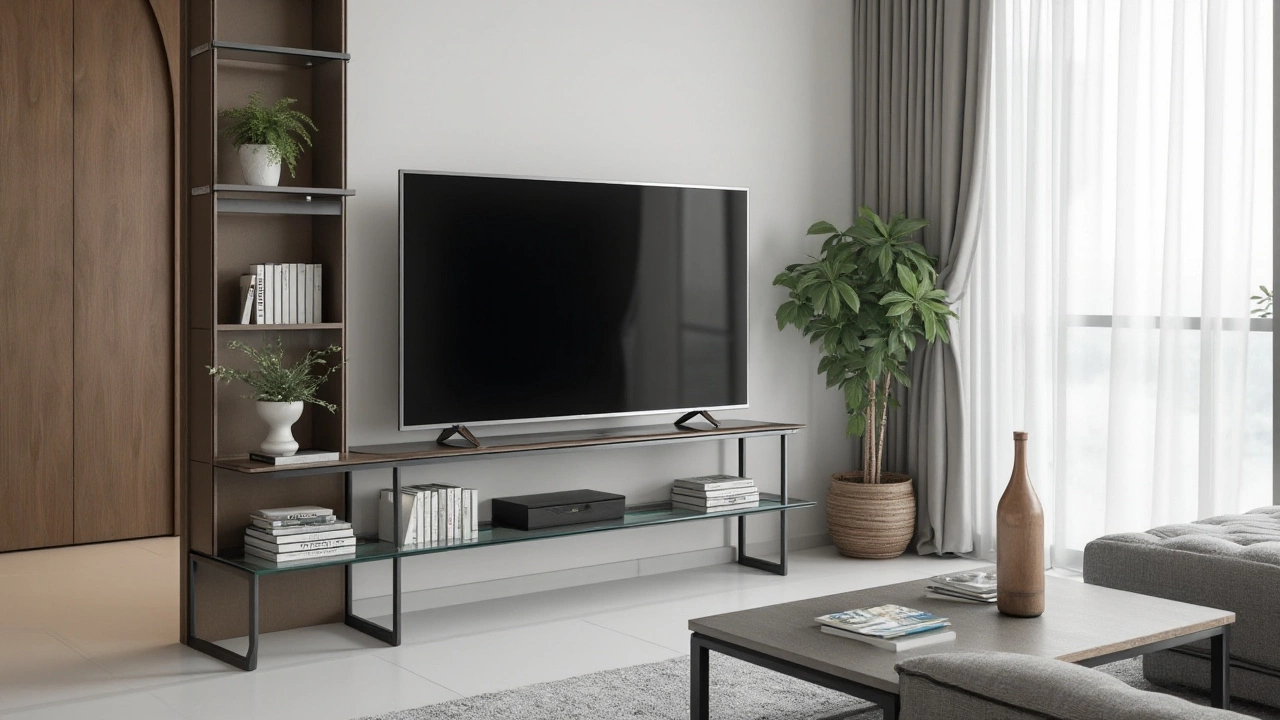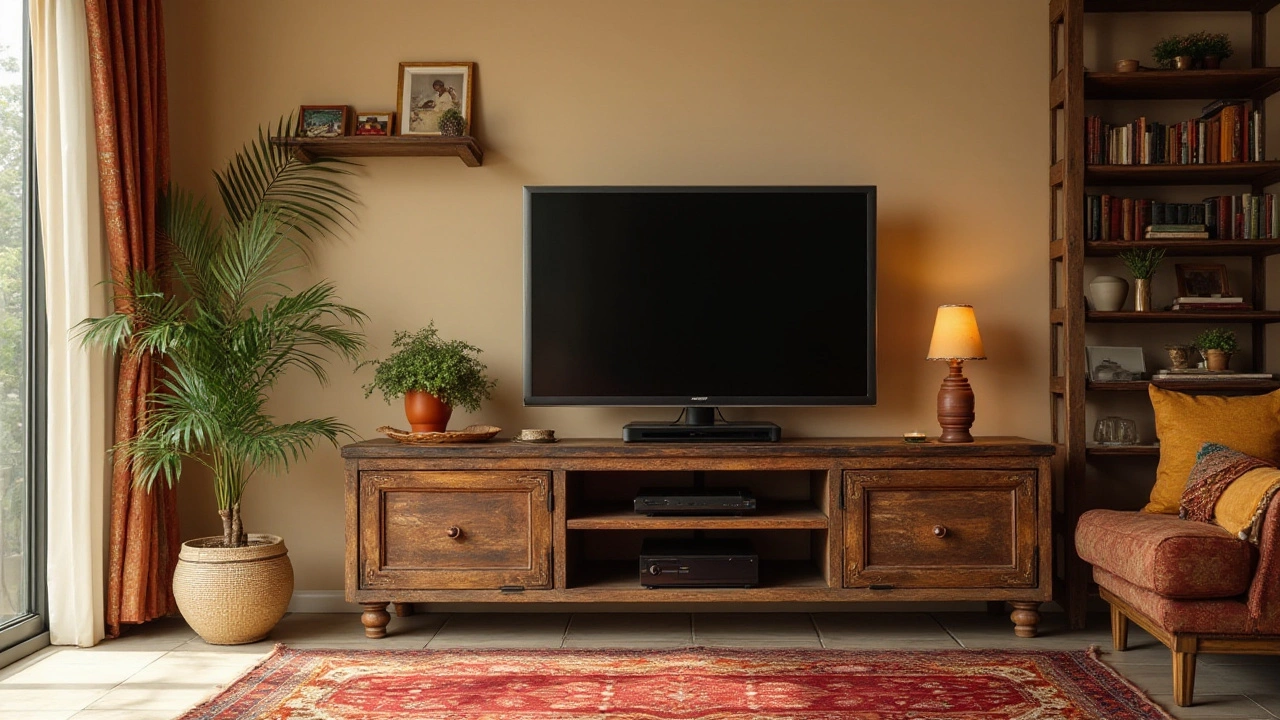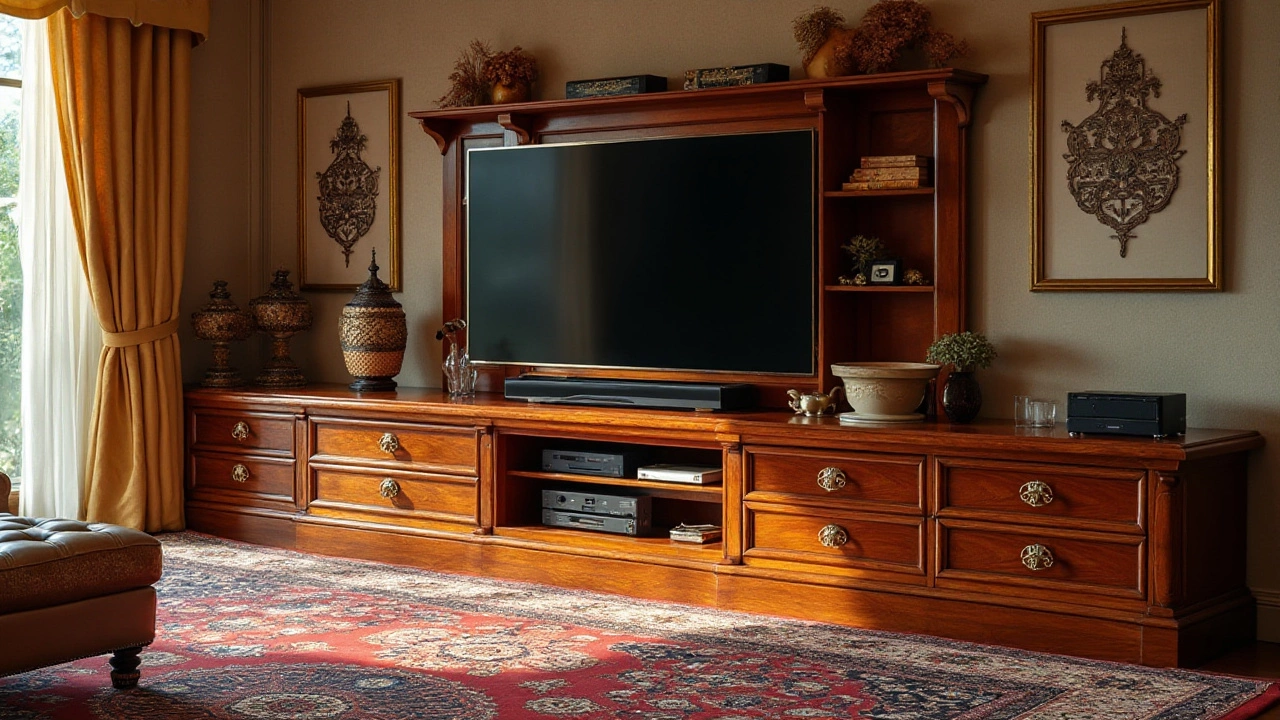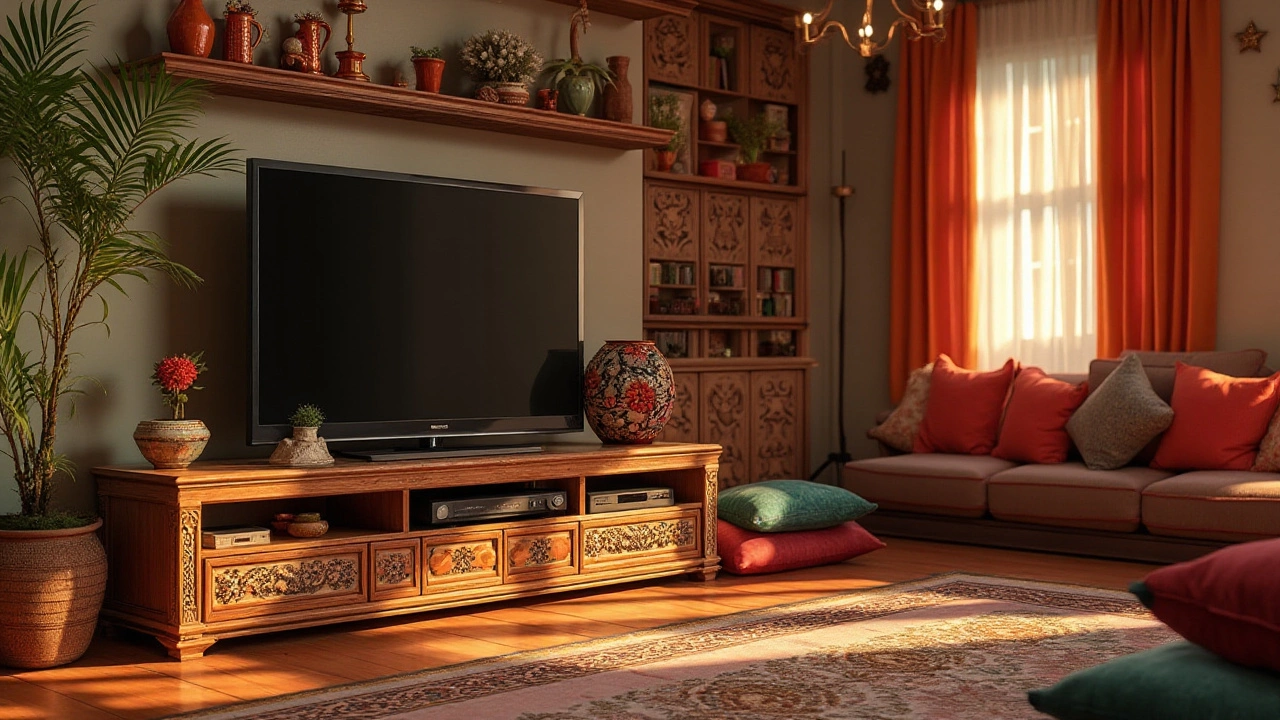The question of whether to place your TV on a stand is often met with diverse opinions, as it’s a decision that hinges on both practical and aesthetic considerations. As screens become larger and sleeker, more individuals are reevaluating their setups to maximize comfort and visual appeal in their spaces.
TV stands are not just about supporting your television; they form an integral part of your living room or entertainment area’s furniture puzzle. The right stand can transform a cluttered room into a haven of organization, while concealing the medley of cables that accompany any modern entertainment system. For those with an eye for interior design, it even becomes a key piece in the room’s overall decor.
This article delves into the benefits of choosing a TV stand, providing insights into making an informed decision that balances style, functionality, and suitability for your lifestyle.
- Advantages of TV Stands
- Choosing the Right TV Stand
- Installation and Placement Tips
- Integration with Room Design
Advantages of TV Stands
When it comes to selecting an apparatus to support your television, TV stands bring a host of benefits that often go overlooked in the debate between stands versus wall mounts. Standing typically involves more than just propping up a screen; it offers an intelligent blend of style, storage, and flexibility. Consider the adaptability a stand provides, allowing for easy repositioning of the television to accommodate different viewing angles. This means family movie night could transform from the living room to a cozy den, simply by shifting the placement of the stand.
One major aspect where TV stands excel is storage. A well-designed stand doesn't just provide a surface for your television; it's a hub for organizing media accessories, such as gaming consoles, cable boxes, and DVDs. This organization feature is especially useful in minimizing clutter and keeping the entertainment area neat, which is increasingly important in open-plan homes where the living room may flow into other areas like the kitchen or dining space. Incorporating materials such as sleek glass, warm wood, or vibrant colors can turn the TV stand into an accent piece that adds to the room's character while maintaining practicality.
Although wall mounts create a modern, streamlined look, they often lack the versatility offered by TV stands. In fact, according to a 2023 report by Home Focus Magazine, “70% of homeowners with TV stands appreciate the ease of movement and the effortlessness in accessing power sources and cables.” This flexibility is a compelling reason to choose a stand, particularly if you're renting and would like to avoid drilling into walls, which could lead to costly repairs or disputes with landlords.
"The versatility of TV stands allows homeowners to adapt their furnishings over time, seamlessly integrating new devices with minimal fuss," says interior design expert Sophia Mollery.
TV stands are also a boon for those who enjoy changing up their room layouts from time to time or for special occasions. They enable a quick reorganization, whether for enhanced audio experience during a home party or to simply refresh the living area's look. Some high-end models even come equipped with built-in mounts that can adjust for height, tilt, and swivel, enhancing the customization options available to users.
Perhaps one of the lesser-discussed but equally important aspects of TV stands is their ability to safely bear weight. Modern televisions, though lighter than their cathode-ray predecessors, still require firm support that a well-built stand can provide. Safety features such as anti-tip straps or sturdy bases ensure that even in homes with children or pets, the stand remains secure and the TV stays stable. By choosing a TV stand, you not only prioritize style and flexibility but also benefit from peace of mind. In the ever-evolving landscape of home entertainment setups, the pros of TV stands clearly position them as a valuable option worth considering.

Choosing the Right TV Stand
When embarking on the journey to select the perfect TV stand, several factors swirl together to form the ultimate decision. It's not just about slapping a piece of furniture beneath your television; it's about curating a centerpiece that harmonizes with your home decor while serving a practical function. First, consider the size of your TV. An ill-fitted stand can seem awkward, either engulfing the room with its bulkiness or appearing too small, leading to imbalances in your visual setup. Most manufacturers provide recommended stand sizes for different TV dimensions, ensuring you don't have to guess.
Another key consideration is the style and material of the TV stand. Home decor styles vary wildly, from the polished sheen of modern minimalist to the warm, rugged charm of rustic aesthetics. Wood often provides a timeless look, complementing various furniture pieces with its natural grain and texture. Meanwhile, glass or metal stands can lend a contemporary edge, perfect for sleek, modern settings. Storage is another element that can’t be overlooked. Many TV stands provide a range of storage options for housing gaming consoles, DVDs, or books. Opting for a stand with shelves or cabinets can aid in decluttering the space.
Bear in mind the weight capacity of the stand, especially if your TV model is on the heftier side. The last thing you'd want is an unstable setup that risks dropping your precious screen. Adjustable stands have also become a popular choice, allowing for flexibility in height and positioning to match your seating arrangements and viewing comfort. According to a recent home survey, 60% of homeowners look for this feature when choosing a TV stand. To complement your chosen piece, consider wire management features. A stand with built-in cable management solutions can neatly obscure the maze of cords often associated with electronic setups, providing a cleaner look.
"The ideal TV stand doesn’t just hold your television - it anchors your living space, creating a focal point that enhances both functionality and aesthetic appeal," says interior designer Jane Randolph.
Finally, factor in the room’s size and layout. A TV stand that fits seamlessly in a spacious living area might not work in a cozy den. Take measurements of your room and plan how the stand will interact with other pieces of furniture. Movement around and interaction with other room functions should remain unhindered. This foresight ensures you avoid overwhelming the area or making other everyday activities cumbersome. Often, mock-up layouts or virtual room planning tools are incredibly helpful in visualizing how your chosen stand will integrate with existing decor. Embrace the process as a part of personalizing your space to reflect both your practical needs and stylistic preferences.

Installation and Placement Tips
Setting up a TV stand successfully is not just about balancing a screen on it. There is a bit more art and science to it. First, consider the height of the stand. Ideally, the center of your television screen should be at eye level from where you're most likely to view it. This usually means the stand height should be roughly 42 inches from the floor, although personal preference and couch height might tweak this slightly. A too-high TV can result in an uncomfortable viewing experience, which over time might strain not only your neck but your all-important binge-watching experience.
Location plays a significant role as well. You’ll want to avoid placing your TV stand against windows or any source of direct light to prevent bothersome glare. If window positioning cannot be helped, consider investing in blackout curtains or adjustable blinds to control natural light. In addition, distance from the seating area to the TV is essential to maintain the clarity and comfort of viewing. As a rule of thumb, multiply the diagonal screen size by 1.5 to 2.5 to estimate this distance. For instance, if you own a 55-inch television, you should place your seating between 6.9 and 11.5 feet away.
Using the TV Stand for More than Just TV
Most people think of TV stands simply as equipment holders, but they can also serve as storage solutions. Select stands with ample shelving or cabinetry. This helps to tidy up any additional electronics, gaming consoles, or even DVDs and books. Arrange cables in an organized manner, using cable management solutions like ties, clips, or integrated channels in the stand itself. A well-managed cable setup not only removes visual clutter but reduces trip hazards, making your entertainment space look cleaner and safer.
"A well-placed TV not only helps enhance your viewing experience but also complements your room’s design," says acclaimed interior designer Alex Greenslade. "People often underestimate the impact of proper TV placement."
Don't forget about ventilation. Electronics generate heat, so allow sufficient airflow around the TV and other connected devices. Many TV stands come with built-in vents or open backs designed to promote necessary cooling. Proper airflow ensures longevity for your electronics, preventing overheating issues that could result in costly repairs or replacements. Remember, taking these thoughtful steps during installation equates to more enjoyable and sustainable usage in the long run.
| Screen Size (Inches) | Recommended Viewing Distance (Feet) |
|---|---|
| 32 | 4.5 - 6.5 |
| 42 | 6 - 8.5 |
| 50 | 7 - 10.5 |
| 60 | 8.5 - 12.5 |
Finally, make sure to evaluate the stability of your TV stand setup. That means checking for a flat, level surface, ensuring that the weight capacity of the stand can support your TV properly. Some stands come with anti-tip hardware or brackets to secure your television, a savvy choice for households with pets or small children. Prioritizing these seemingly minor details can save you from potential accidents, ultimately offering peace of mind and a better free time environment where you can sit back, relax, and enjoy your favorite shows or a movie marathon stress-free.

Integration with Room Design
Integrating a TV stand into your room design demands a thoughtful approach that considers both form and function. TV stands have the unique ability to anchor a space; they are often the centerpiece of the living or entertainment room. This makes it crucial to select a design, material, and color that don't just match but enhance the aesthetic of the rest of your decor. When chosen wisely, a TV stand can harmonize with your surroundings, providing a cohesive look that ties the room together. Consider those rich, dark wood stands that complement traditional or rustic themes, while sleek, minimalistic metal or glass stands might suit a modern setting better—each adding a distinct vibe.
When planning your room, it's essential to think about visibility and comfort as well. The height of the TV stand affects viewing angles, which can greatly impact your watching experience. Aim for the middle of the screen to be at eye level when seated. This helps in reducing neck strain and optimizing viewing pleasure. Additionally, stands with adjustable shelves and ample storage not only manage electronics gracefully but keep visual clutter to a minimum by providing space for storing remotes, DVDs, and more. Interior designers often suggest that ergonomic design goes hand in hand with aesthetic appeal, creating spaces where style and practicality meet.
There's also the aspect of lighting to consider when choosing a TV stand. How light falls on and around the stand can alter the ambiance of your room. Strategically placed lamps or downlights can highlight particular features of the stand, such as grain patterns on wood or the shimmer of metal, adding layers to your room's atmosphere. Proper lighting can enhance the immersive experience of watching TV, creating a cozy nook that blends seamlessly into the rest of your home.
Durability is another factor that shouldn't be overlooked. A well-built TV stand not only supports your valuable television but also endures the test of time and usage. Investing in a stand that is constructed from quality materials ensures that it withstands daily wear and enhances the room's design element for years to come. Choose wisely and consider it an investment in both your sanctuary's aesthetics and functionality.
Interestingly, a quote from interior designer Nate Berkus captures this essence well:
"Your home should tell the story of who you are, and be a collection of what you love."A well-integrated TV stand is an expression of personal taste that narrates part of that story. Emphasizing visual harmony while addressing functional needs reflects deeply on who you are, making every corner of your home truly yours.
Lastly, TV stands provide an opportunity to showcase personal accents, incorporating room design elements like family photos, artworks, or sculptures. These elements not only personalize your space but add texture and layers to your home decor, making your entertainment area uniquely yours. Don't just view your TV stand as a piece of furniture; consider it a canvas that brings your creative room design to life.

